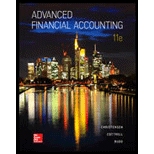
Bondsof affiliate purchased from non-affiliate: When an affiliate of issuer later acquires bonds form unrelated party, the bonds are retired at the time of purchase. The bonds are not held outside the consolidated entity once another company within the consolidated entity purchases them; it must be treated as repurchase by debtor. Acquisition of an affiliate’s bonds by another company with in affiliated entities is referred as constructive retirement.
When constructive retirement occurs, the consolidated income statement report gain or loss based on the difference between carrying value and purchase price paid by affiliate to acquire it. It is not reported in consolidated
The worksheet consolidation entries as of December 31, 20X4, to remove the effects of intercompany bond ownership
Want to see the full answer?
Check out a sample textbook solution
Chapter 8 Solutions
Advanced Financial Accounting
 Intermediate Accounting: Reporting And AnalysisAccountingISBN:9781337788281Author:James M. Wahlen, Jefferson P. Jones, Donald PagachPublisher:Cengage Learning
Intermediate Accounting: Reporting And AnalysisAccountingISBN:9781337788281Author:James M. Wahlen, Jefferson P. Jones, Donald PagachPublisher:Cengage Learning College Accounting, Chapters 1-27AccountingISBN:9781337794756Author:HEINTZ, James A.Publisher:Cengage Learning,
College Accounting, Chapters 1-27AccountingISBN:9781337794756Author:HEINTZ, James A.Publisher:Cengage Learning, Cornerstones of Financial AccountingAccountingISBN:9781337690881Author:Jay Rich, Jeff JonesPublisher:Cengage Learning
Cornerstones of Financial AccountingAccountingISBN:9781337690881Author:Jay Rich, Jeff JonesPublisher:Cengage Learning- Principles of Accounting Volume 1AccountingISBN:9781947172685Author:OpenStaxPublisher:OpenStax College
 Excel Applications for Accounting PrinciplesAccountingISBN:9781111581565Author:Gaylord N. SmithPublisher:Cengage Learning
Excel Applications for Accounting PrinciplesAccountingISBN:9781111581565Author:Gaylord N. SmithPublisher:Cengage Learning





